Organs of movement of molluscs. The life processes of mollusks (digestive, excretory, circulatory, respiratory, nervous systems; sensory organs, development, reproduction)
1. General data
The sizes of mollusks range from 0.5 mm (some gastropods) to 15 meters (giant squid Architeuthis dux (Steenstrup, 1875) - adults of this species have repeatedly caught fishing boats and found remains washed ashore). Mollusks have a secondary body cavity (coelom), which is represented in them by the pericardial cavity (pericardium) and the cavity of the sex glands (gonads). Mollusks are bilaterally symmetrical animals, however, some of them (class Gastropoda) lost their symmetry for the second time as a result of displacement of a number of organs (torsion process). The body of mollusks is not segmented (only in some groups signs of metamerism appear), it usually consists of three sections - the head, trunk and legs. The chair may be partially or completely reduced. On the head are a mouth, tentacles and eyes. The leg is a muscular thickened outgrowth of the abdominal wall of the body, which in most cases performs a locomotor function (movement). The toelub is kept above the leg.
2. Veil
clam shells
It is believed that in the hypothetical ancestor of mollusks, the cover was represented by some so-called protoperinotum: a cuticle with aragonite spicules. A similar structure of the cover is characteristic of representatives of the classes Caudofoveata and Solenogastres. However, in all classes of mollusks, except for Caudofoveata, a ciliated animal surface appears - a leg (on this basis, they are combined into the Adenopoda group). In Solenogastres, the leg is represented by the inhibitory groove. Polyplacophora also have a cuticular covering, but only on lateral surfaces called perinatal folds. The dorsal surface is covered by eight shell plates.
5. Circulatory system
6. Respiratory system
Most aquatic (rapana, murex) breathe with gills (ctenidiams), and terrestrial (grape snail) and some aquatic (large and small pond snails) lungs. Air enters the lungs through the breathing hole, where the blood is saturated with oxygen and released from it. carbon dioxide. Mollusks have blood of blue color. This causes high level copper in the blood.
7. Nervous system
Nervous system gastropods consists of ganglions interconnected and nerves. This type of nervous system is called scattered-nodular.
Features of the internal structure. Mollusk muscles are represented by separate bundles that perform certain functions: some of them draw the leg and head inside the shell, leg muscles provide movement. Special closing muscles, contracting, close the shell valves in bivalve molluscs.
body cavity mollusks, as well as annelids, secondary. But the gaps between the internal organs are mainly filled with loose connective tissue.
Digestive system molluscs begins with a mouth opening, and ends with an anal opening into the mantle cavity. On the border between the mouth opening and the pharynx, there may be horny jaws. The pharynx has a muscular outgrowth - a tongue covered with rows of horny teeth. This forms a grater, with which the mollusks scrape food from various surfaces. The ducts of the salivary glands open into the pharynx. In cephalopods and some gastropods, the composition of saliva, in addition to digestive juices, includes poisonous substances that kill prey - various marine invertebrates and fish. The middle section of the intestine forms a sac-like expansion - stomach. The ducts of the digestive gland open into it - liver (Fig. 142).
excretory organs shellfish - kidneys. One duct opens each kidney into the pericardial cavity, the other into the mantle. The end products of metabolism are excreted there.
Circulatory system mollusks, like arthropods, open. There is a muscular organ - the heart, consisting of chambers: one or more atria and ventricle (Fig. 142). Blood from the heart moves through arteries, and returns to the heart veins. Like arthropods, the blood of mollusks mixes with the abdominal fluid. The blood is most often colorless, sometimes red.
Since most mollusks are inhabitants of water bodies, respiratory system they have - gills. Therefore, they breathe oxygen dissolved in water. Terrestrial and some freshwater shellfish respiratory organ - lung. This is the part of the mantle in which the blood vessels branch. The lung allows you to breathe atmospheric oxygen. Therefore, the inhabitants of reservoirs, having a lung, from time to time are forced to float to the surface of the water in order to capture air.
In most molluscs nervous system consists of nerve ganglions located in different parts bodies connected by nerve trunks (Fig. 143). This type of nervous system is called scattered-nodal. In shellfish leading active image life (for example, cephalopods), a complex brain is formed.
sense organs molluscs are varied. The skin contains receptors that perceive mechanical, chemical and physical stimuli (various chemical substances, touch, temperature, etc.). There are especially many receptors on the tentacles located on the head. The organs of vision - the eyes - are the most complex cephalopods. In bivalve mollusks, due to a sedentary lifestyle, the sense organs are poorly developed.
Reproduction and development. Among mollusks, both dioecious species and hermaphrodites are found. Fertilization can be both internal and external. For most marine species characterized by indirect development. They meet larvae that live in the water column and ensure the resettlement of the species. In most freshwater and all terrestrial species direct development. Since mollusks grow throughout their lives, their shells gradually increase in size. material from the site
Complications of the structure and life processes of mollusks in comparison with annelids:
- the body consists of departments: head, torso and legs;
- the circulatory system is open, there is a heart that provides blood circulation;
- there are specialized respiratory organs - gills or a lung.
The internal structure and life processes of mollusks also have the following features:
- there is a through intestine and digestive glands - salivary and liver;
- excretory organs - kidneys;
- nervous system of scattered-nodular type;
- there are both dioecious species and hermaphrodites; fertilization, both external and internal, development, direct or indirect;
- They live in fresh and salt water bodies, as well as on wet land areas.
On this page, material on the topics:
Table of the evolution of the digestive system from unicellular to molluscs
What are the nervous system and sensory organs of molluscs
Organs of excretion and reproduction of molluscs
Compare the structure of arthropods and mollusks
Report on structural features of the digestive system of molluscs
Questions about this item:
photo: Art
In wildlife, mollusks are found almost everywhere - they are found in the thickness of ocean waters, and high in the mountains, in salty and fresh water, on the ground and underground. They don't just live in sandy deserts and in the snow.
The diversity of the habitat explains the fact that mollusks differ in body structure, its color and shape, methods and speed of movement, and other features.
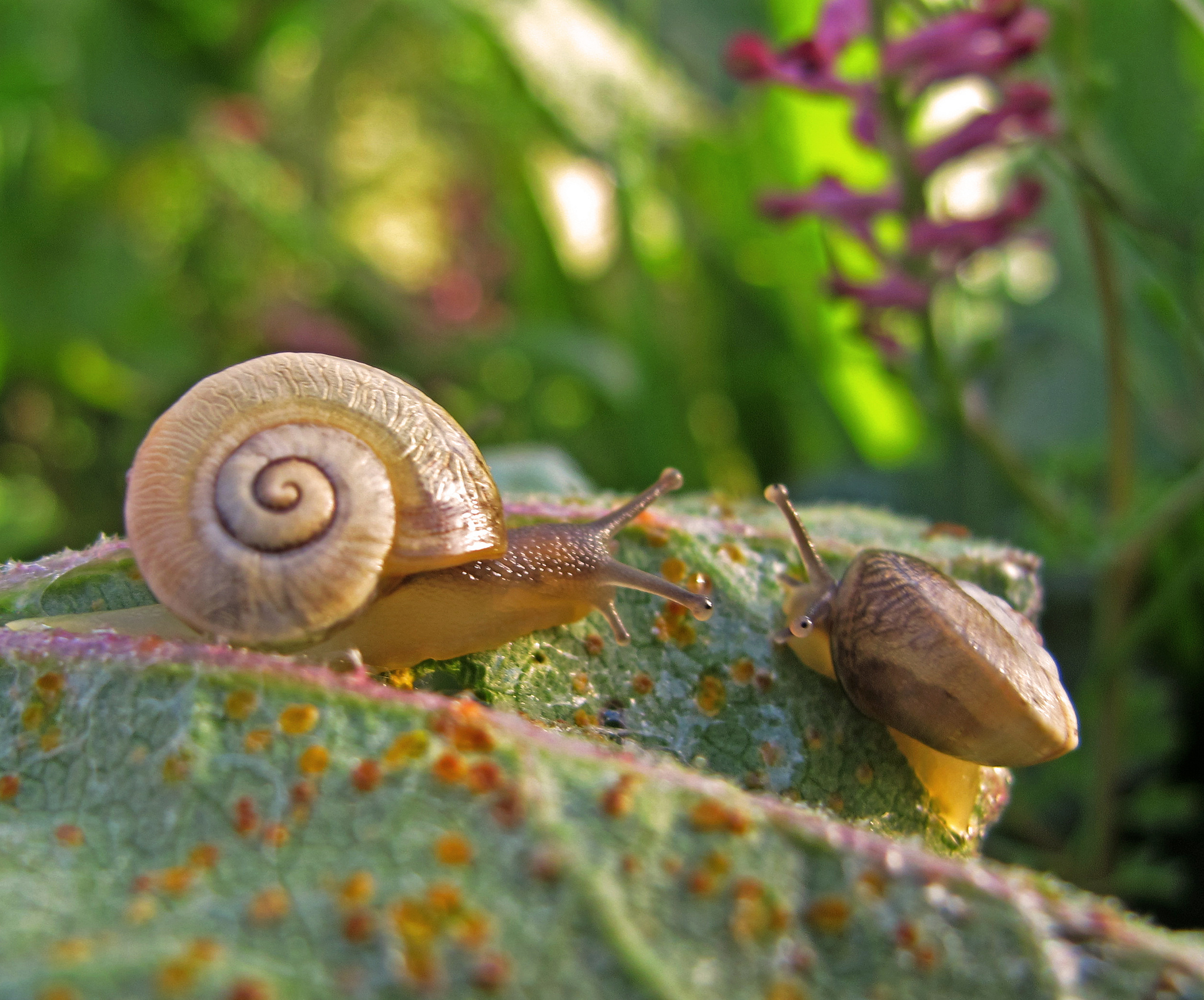
photo: jacinta lluch valero
But despite this, they have some common features: The mollusk consists of a head, torso and legs. Most species are "equipped" with an outer shell, which consists of proteins and calcium carbonate. Sink plays protective function- the mollusk hides in it at the slightest danger. It can be single or double sided. The body of the mollusk, like the shell, in most individuals is a spiral.
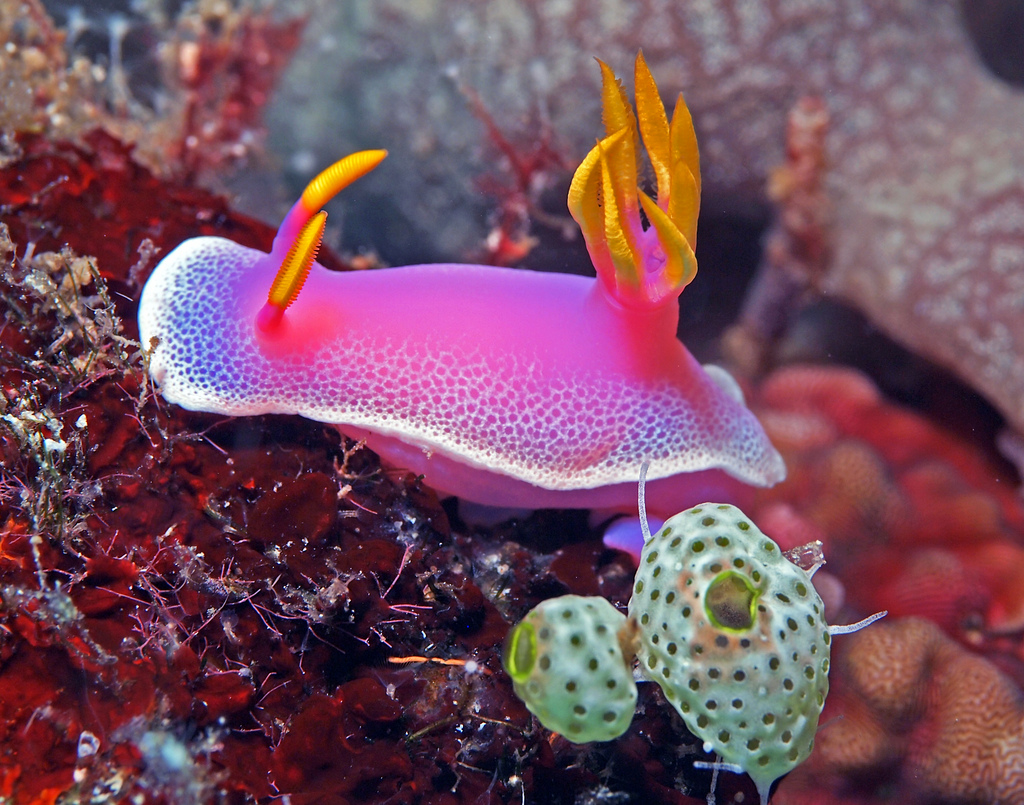
photo: divemecressi
The internal organs of mollusks are located in the body, in some species they are displaced into the leg. There are mollusks that do not have a head - it has disappeared as unnecessary. The absence or presence of eyes, tentacles, the shape and size of the shell, location features internal organs- all this depends on the way of evolution, habitat, nutrition of certain species of these invertebrates. It should be noted that molluscs are the first animals to have a liver.
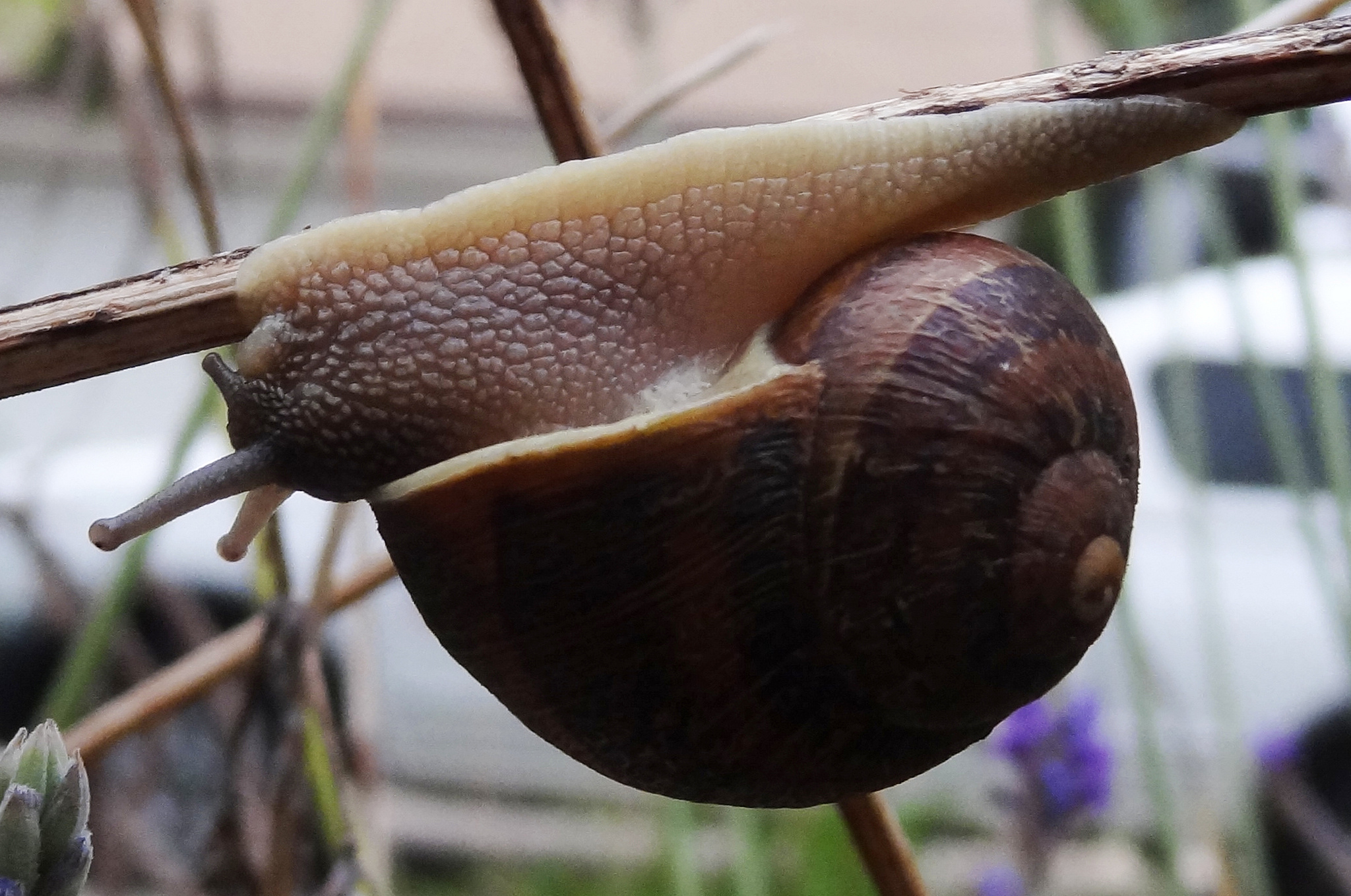 photo: Martin LaBar
photo: Martin LaBar
The first fossil mollusks date back to the Cambrian period. Their ancestors are considered annelids with outer segmentation. At the beginning of their evolution, cephalopods predominated, later bivalves and gastropod species. Modern scientists Special attention devoted to the study of the evolution of mollusks, which can be traced through the preserved shells. This makes it possible to learn the features of the development of not only invertebrates, but also the rest of the animal world, because mollusks are an important component of the diet of fish, birds and mammals.
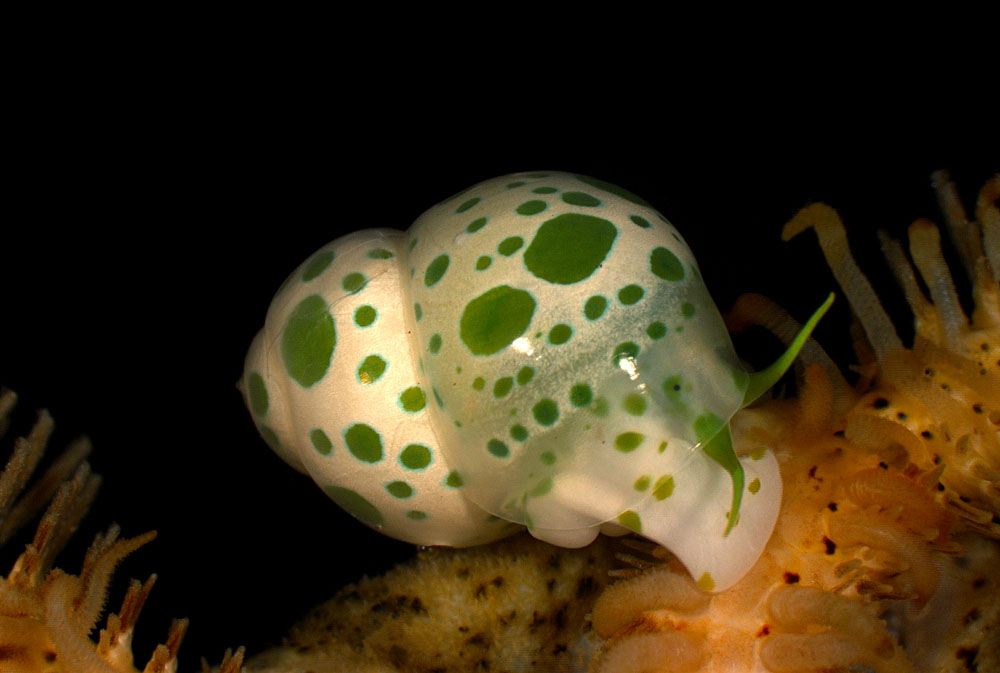 photo: Art
photo: Art
Today, after all, there are seven classes of molluscs. The most popular of them are gastropods, bivalves and cephalopods.
gastropods- one of numerous kinds living literally everywhere. These are water and land snails. Moreover, in aquatic gastropods, the respiratory organ is the gills, while in land animals they have transformed into lungs, which allows snails to be independent of the reservoir and live a full life on land. Bivalves are difficult to confuse with other species - they have a characteristic shell consisting of two closed valves. The body of the mollusk is enclosed between the valves. At the slightest danger, the doors slam shut, and in the normal state they are ajar. bivalves live in aquatic environment, both in salt and fresh water at different depths.
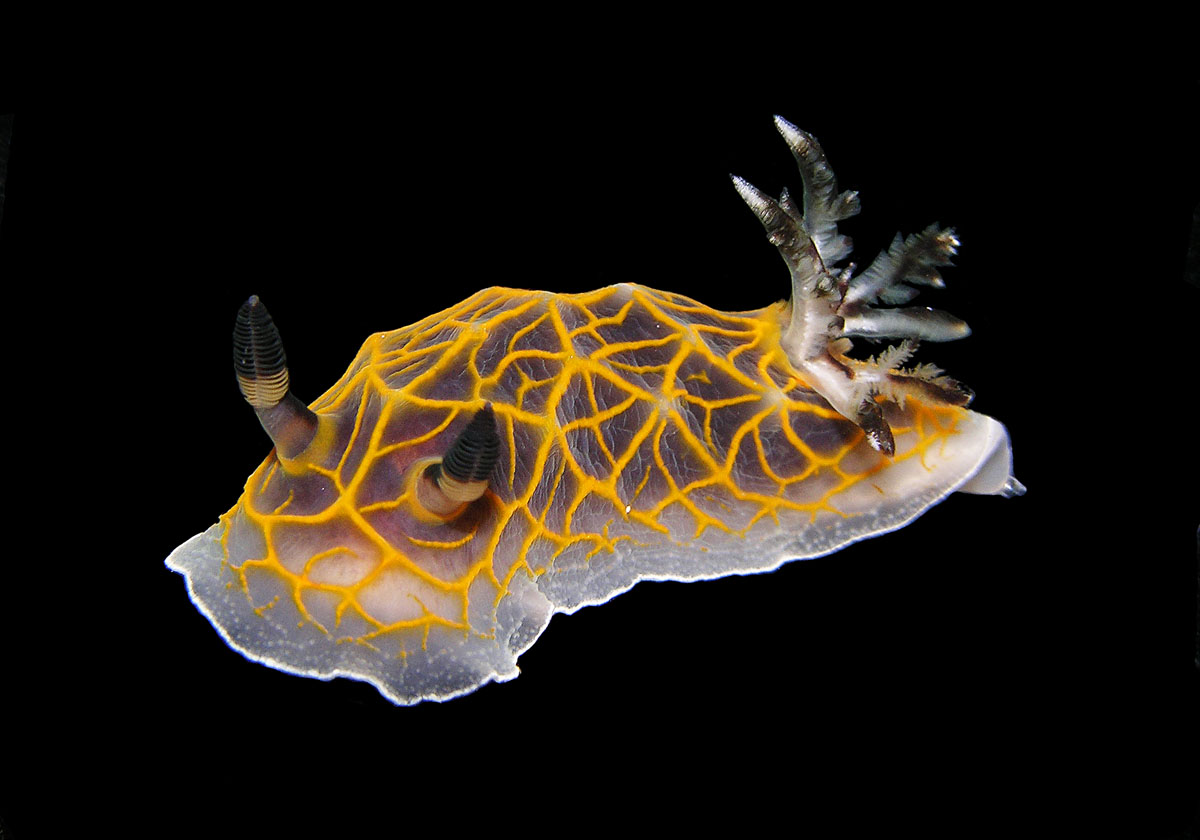
The class of the most complexly organized, large, and sometimes very large free-living mollusks.
a brief description of
|
Structure |
The body is bilaterally symmetrical with a sharp division into the head and trunk. The leg is turned into tentacles, or arms. The shell is rudimentary. The torso is dressed on all sides with a mantle |
|
Digestive system |
Mouth, muscular throat. Tongue with radula. Esophagus, muscular stomach. The small intestine ends in powder. Liver |
|
Respiratory system |
|
|
Circulatory system |
The heart consists of one ventricle and two or four atria. The circulatory system is not closed. Blood contains hemocyanin, which makes it blue when exposed to air. |
|
excretorysystem |
Consists of two or four kidneys. The internal opening of the kidneys opens into the pericardium, the external - into the mantle cavity |
|
Nervous system |
The peripharyngeal ganglia are large and form a common peripharyngeal mass, from which two large mantle nerves arise. |
|
sense organs |
Organs of smell. Developed organs of vision |
|
reproductive system |
Cephalopods are dioecious, sometimes with sharp sexual dimorphism. Fertilization is internal, occurs in the mantle cavity of the female |
|
Development |
All development takes place inside the egg shell. |
general characteristics
Structure . Body comprises heads, legs and torso. Head and torso, unlike gastropods, do not have a clear distinction. On the dorsal side of the body mantle forms covers of the body, and on the abdominal - separated from the body mantle cavity. At the place of transition of the body
in the head the mantle cavity has abdominal opening to communicate with external environment. The mantle cavity contains funnel, which grows to the body (Fig. 1). One end of the funnel opens into the mantle cavity, the other goes out through the abdominal opening. By using mantle muscles the mantle fits snugly to the body, and water is forced outward through the funnel from the mantle cavity. The muscles then relax and the cavity fills up with water again. Due to such rhythmic contractions of the mantle muscles, swimming movements and molluscs move backwards forward. The leg in cephalopods is very much modified: it fit funnel and tentacles. Tentacles form perioral crown.
Rice. one.Cuttlefish with an open mantle cavity (view from the ventral side): 1 - arms with suckers; 2 - trapping hand; 3 - mouth; 4 - funnel opening; 5 - funnel; 6 - cartilaginous pits of cufflinks; 7 - anal papilla with anus; 8 - renal papillae; 9 - unpaired genital papilla; 10 - gills; 11 - fin; 12 - cut line of the mantle; 13 - unfolded mantle; 14 - cartilaginous tubercles of cufflinks; 15 - mantle stellate ganglion
In lower forms ( boat) - an indefinite number of identical tentacles. In some higher cephalopods ( octopuses) available 8 well-developed large tentacles of the same size. Other's ( cuttlefish, squid) besides this, there is also 2 much longer tentacles with extensions at the ends. The tentacles of higher cephalopods bear numerous large disc-shaped suckers, serving to capture prey or attach to the bottom. The shell is present only in ancient forms. In most cephalopods the shell is rudimentary. The connective tissue layer of the skin contains numerous pigment cells, or chromatophores, with which under the control of the nervous system of the molluscs can change body color. In cephalopods, unlike other molluscs, one can distinguish a special internal skeleton - cartilaginous head capsule, which protects the central nervous system and physiologically corresponds to the skull of vertebrates.
Digestive system
(Fig. 2). Mouth lies in the center of the crown of tentacles. Next comes pharynx with radula. Appear in the throat two thick horny jaws, similar to the beak of a parrot, which are mainly involved in capturing and crushing food. Fall into the throat ducts of two pairs of salivary glands(the couple's secret glands are poisonous).
The pharynx continues into the esophagus, which often forms a goiter, and further into the sac-like stomach. After the stomach comes the small intestine, which ends with the hindgut and anus. Liver ducts enter the stomach
seated with numerous glandular appendages, which are often called the pancreas.
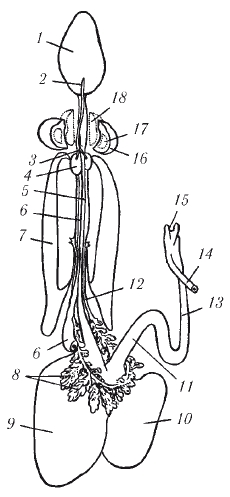
Rice. 2. Digestive system of cuttlefish (from the ventral side): 1 - pharynx; 2 - common salivary duct; 3 - salivary duct; 4 - back salivary gland; 5 - esophagus; 6 - head aorta; 7 - liver; 8 - pancreas; 9 - stomach; 10 - blind sac of the stomach; 11 - small intestine; 12 - hepatic duct; 13 - rectum; 14 - ink bag duct; 15 - anus; 16 - head cartilaginous capsule (cut); 17 - cavity of the statocyst capsule; 18 - nerve ring (cut)
Respiratory system. The respiratory organs, like all mollusks, are in the mantle cavity. Gills located symmetrically on the sides of the body. The exchange of water in the mantle cavity is carried out due to the activity mantle muscles and funnels.
Circulatory system. Heart cephalopods are made up of one ventricle and two or four atria. depart from the stomach two large aorta: head(carries blood to the head and tentacles) and splanchnic(supplies blood to the intestines and genitals). Cephalopod blood contains hemocyanin, so in the air turns blue.
excretory system. kidneys represent bags, the front openings of which open near the powder, and internal - in the pericardial part of the coelom. Blind protrusions of the vena cava protrude into the walls of the kidneys - venous appendages which facilitate the removal of metabolic products from the blood. Kidneys, like gills, can be 2 or 4.
Nervous system cephalopods reaches the greatest complexity of the structure compared to other molluscs. ganglia enough great and form a single peripharyngeal nerve mass(Fig. 3).
Sense organs. Olfactory organs located at the base of the gills or under the eyes. organs of vision can be represented by large eye fossae, the cavity of which communicates with the external environment through a small hole, or eyes, in structure resembling the eyes of mammals. The compound eyes of cephalopods have accommodation at the expense approximation or removal of the lens from the retina. Also available adaptations for vision in strong and low light.
Deep-sea cephalopods have special glow organs.
Sexual system. cephalopods separate sexes. In some species, there is sexual dimorphism. Fertilization most often occurs in the mantle cavity of the female, where are formed and egg shells. All development proceeds inside the shells of the egg and without metamorphosis.
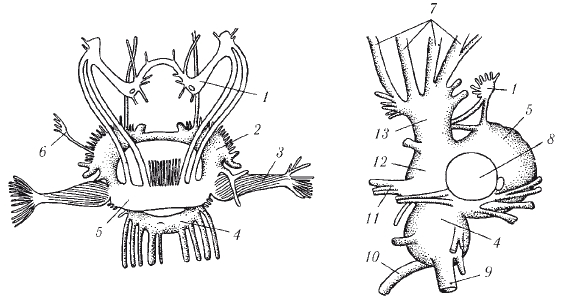
Rice. 3. The central nervous system of cephalopods: 1 - buccal ganglion; 2 - pedal ganglion; 3 - optic nerve; 4 - visceral ganglion; 5 - cerebral ganglion; 6 - nerve going to the hood and tentacles; 7 - nerves of the hands; 8 - the place of origin of the optic nerve; 9 - mantle nerve; 10 - nerve going to the insides; 11 - funnel nerve; 12 - infundibular ganglion; 13 - brachial ganglion (12 and 13 - derivatives of the pedal ganglion)
